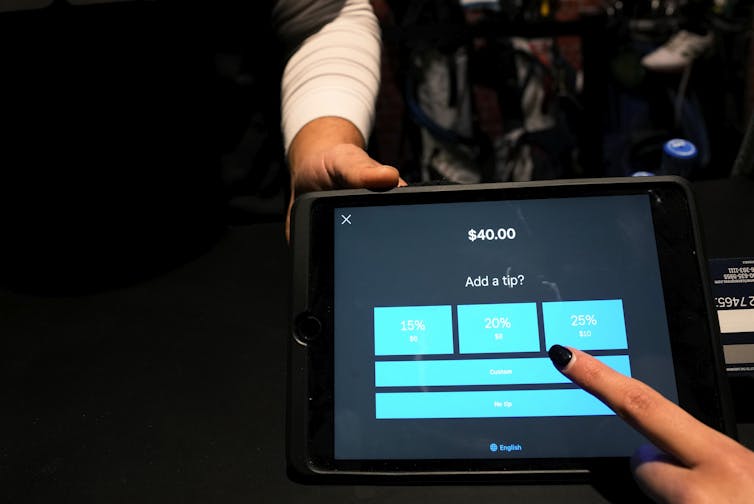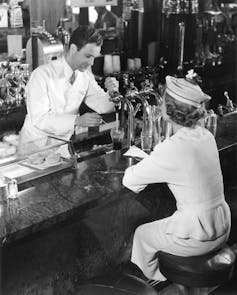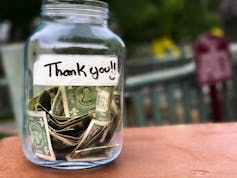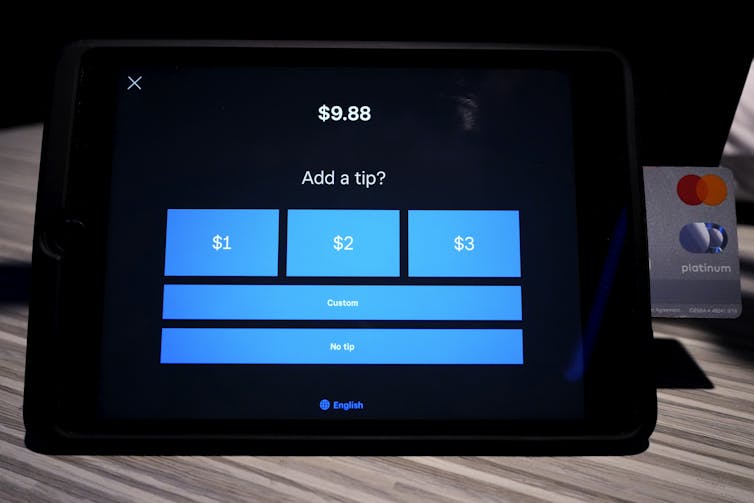Here’s how you can avoid feeling flustered or ripped off
Nathan B. Warren, BI Norwegian Business School and Sara Hanson, University of Richmond
 |
| Digital payment methods may automatically prompt you to leave a gratuity. AP Photo/Nam Y. Huh |
The ever-growing list of situations in which you might be invited to tip includes buying a smoothie, paying an electrician, getting a beer from a flight attendant and making a political donation.
Should you always tip when someone suggests it? If yes, how do you calculate the right amount? And if you don’t, are you being stingy?
As marketing professors who specialize in customer interactions, we’re researching how digital payment technologies have changed how and when customers tip. Our research suggests that asking for tips before service and suggesting tip amounts that are too high can frustrate customers and be bad for business.
What’s new
U.S. customers historically tipped people they assumed were earning most of their income via tips, such as restaurant servers earning less than the minimum wage. [In Rhode Island, the minimum wage is only $3.89 an hour compared to the $12.25 minimum wage for non-tipped workers. - W. Collette].
In the early 2010s, a wide range of businesses started processing purchases with iPads and other digital payment systems. These systems often prompted customers to tip for services that were not previously tipped.
Today’s tip requests are often not connected to the salary and service norms that used to determine when and how people tip.
Customers in the past nearly always paid tips after receiving a service, such as at the conclusion of a restaurant meal, after getting a haircut or once your pizza was delivered. That timing could reward high-quality service and give workers an incentive to provide it.
It’s becoming more common for tips to be requested beforehand. And new tipping technology may even automatically add tips.
Tip creep and tipflation
The prevalence of digital payment devices has made it easier to ask customers for a tip. That helps explain why tip requests are creeping into new kinds of services.
Customers now routinely see menus of suggested default options – often well above 20% of what they owe. The amounts have risen from 10% or less in the 1950s to 15% around the year 2000 to 20% or higher today. This increase is sometimes called tipflation – the expectation of ever-higher tip amounts.
The COVID-19 pandemic, which hastened the adoption of digital payments and increased sympathy for service workers, amplified both tip creep and tipflation.
 |
| Tips used to be smaller. George Marks/Retrofile RF via Getty Images |
Tipping has always been a vital source of income for workers in historically tipped services, like restaurants, where the tipped minimum wage can be as low as US$2.13 an hour.
Tip creep and tipflation are now further supplementing the income of many low-wage service workers.
Notably, tipping primarily benefits some of these workers, such as waiters, but not others, such as cooks and dishwashers. To ensure that all employees were paid fair wages, some restaurants banned tipping and increased prices, but this movement toward no-tipping services has largely fizzled out.
So, to increase employee wages without raising prices, more employers are succumbing to the temptations of tip creep and tipflation. However, many customers are frustrated because they feel they are being asked for too high of a tip, too often. And, as our research emphasizes, tipping now seems to be more coercive, less generous and often completely dissociated from service quality.
While digital tipping can be an easy way for customers to help workers or express their gratitude for good service, many Americans feel uncertain about what to do when asked for a tip.
3 questions to always ask
Here are some questions you can ask yourself when faced with almost any tipping decision.
1. Should I tip?
It’s generally up to you to decide whether you will tip and how much.
To avoid being pressured into tipping when you don’t want to, establish your own norms for different services. That will make you less likely to be surprised by an unexpected or high-pressure tip request. Many customers do pay tips in those situations but get upset.
 |
| Sometimes it’s best to chip in with a little cash. Catherine McQueen/Moment via Getty Images |
We also recommend tipping employees you believe are being paid less than a fair wage. Though it can be difficult to determine whether employees are underpaid, learning whether your state or city guarantees a minimum wage that’s well above the federal requirement can help.
For many tipped services, quality varies widely. In these situations, you can use tips to reward better service, if you pay after receiving it; or you can give workers a tip beforehand as an incentive to treat you well.
Likewise, pay a tip if you’re likely use the service again. You will earn a reputation as a good or bad tipper, and employees will treat you accordingly.
There’s a wide range of services that may or may not require a tip. These include quick-service cafes and takeout, where customers order at a counter rather than being waited on at a table. You will need to decide what to do in those situations on a case-by-case basis. Tipping a barista who has skillfully prepared your fancy latte makes more sense to us than tipping a worker who rings up a can of soda.
In many instances, paying and tipping in cash makes the most sense because you can avoid coercive technology and ensure that the employee who helped you directly receives the tip. That way, the employee will know you appreciate their service, and you can be fairly certain that their employer is not somehow swiping their tip money.
2. How much?
This question is especially important when preservice tips are requested. If service quality may vary based on your response, for example with food delivery, food trucks, bars and restaurants, we suggest tipping the middle or high default tip amount, which will often be around 20%, or a flat dollar amount that is the rough equivalent. That approach will avoid the possibility of getting poor service. Of course, this can result in frustration if service doesn’t meet your expectations.
When is it OK to just say no? AP Photo/Nam Y. Huh
An alternative strategy is to tip the lowest recommended option, which is often close to 10%, then add an additional cash tip if the service is good. While using this strategy risks bad service, it’s a wise way to go if you plan to be a repeat customer.
3. Can I skip it this time?
If a tip request comes as a surprise, that usually means there is no norm you’re familiar with for that service. We recommend that you don’t tip in that situation, despite the social pressure.
If you wind up tipping anyway, we recommend either not returning to the business or writing a polite but critical review online describing your uncomfortable experience.
We don’t believe there’s a reason to feel guilty leaving no tip or a low tip when you are using a service that is not traditionally tipped or where service quality is not affected by the tip amount, such as when making a donation or ordering an office chair from an internet retailer.
Ultimately, tipping is voluntary, which makes it a personal choice.
But whether you tip or not, you should always treat service workers well, especially tipped service workers. They are often exposed to the worst customer behaviors, including harassment, which is never appropriate – no matter how much a customer tips.![]()
Nathan B. Warren, Assistant Professor of Marketing, BI Norwegian Business School and Sara Hanson, Associate Professor of Marketing, University of Richmond
This article is republished from The Conversation under a Creative Commons license. Read the original article.